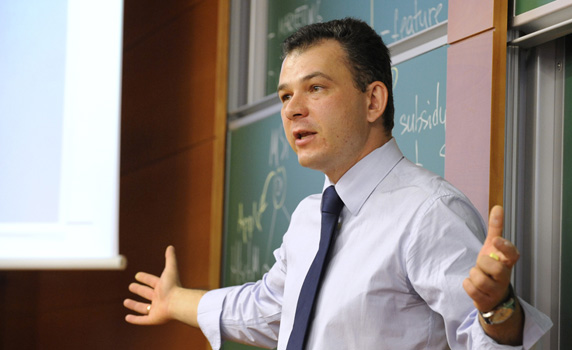
In organizations like UNICEF, the quality of one’s leadership can literally mean the difference between life and death.
So says human resources specialist, Mariam Kakkar. Manager of the UNICEF Leadership Academy, it is Kakkar’s job to develop the management and leadership skills of UNICEF staff in support of strategic goals. One of the speakers at this month’s Leadership Development Think Tank at IESE New York, Kakkar shared thoughts on partnerships, and on building leadership competencies across the entirety of an organization – key to the likes of UNICEF, where “the stakes are universally and permanently high.”
Joining Kakkar were IESE experts and faculty members, including Professor Evgeny Káganer, professor of information systems. Prof. Káganer called for new learning models and a “seamless” approach to leadership development in a landscape prone to “increasing digital density.”
Leadership Development at UNICEF
In the face of increasing geopolitical uncertainty and crises, competition from other organizations for funding and pressure from governments to deliver more efficient, innovative strategies, UNICEF found that there were pan-organizational challenges that needed to be addressed.
Kakkar said that they noticed skills gaps and a deficiency in leadership skills across the organization not limited to specific groups of levels. These gaps touched diverse areas from change management to strategic planning.
The solution for UNICEF, she says, has been to shift the focus from the development of individual leaders, to a broader definition of leadership development. This has meant implementing systemic leadership development opportunities for every member of the organization: an enterprise-wide approach that touches the entirety of its employee base.
“Developing leadership skills universally is key,” she said. “At UNICEF, we now prioritize the optimization of skills of every single employee – from our technical and support staff, right up to our senior executives.”
She also highlighted a need for organizational coherence and consistency in leadership development – something that many organizations, including UNICEF, have “only recently begun to understand.”
“Comprehensive and effective leadership development should not be based on a series of independent events or distinct actions. It needs to be a cohesive program that takes individuals on a journey towards developing their own leadership competencies.”
The Leadership Academy
To meet these strategic needs, UNICEF developed its Leadership Academy: an innovative approach that has sought to redefine “leadership” in terms of a range of competencies and aptitudes that can be systematically developed across the breadth of its employee base.
The Academy delivers a broad spectrum of leadership programs, in partnership with leading business schools including IESE, Cambridge Judge and Harvard Business Publishing.
“Partnering with leaders in the education space has been key to the success of the Academy,” says Kakkar. “In this process we were guided by our business needs. So our choices reflect the best fit in terms of compatibility with the strategic goals of the Academy – and on how well our partners complement each other.”
“Everybody can strive to acquire and develop leadership skills,” says Kakkar. “And everybody has a place within the Academy.”
Leadership Development in the Digital Era
How do you develop leaders in the information age, asked Evgeny Káganer. Drawing on his research into the use of social and mobile technologies in business and education, Prof. Káganer’s talk touched on the “disappearing line between the digital realm and the real world.”
This blurred boundary results from what Káganer calls increasing digital density: the ‘density’ of connections, context, and communications flowing across digital technologies. As more and more interactions are realized through digital technologies, said Káganer, we need to re-evaluate the effectiveness of traditional models of education and leadership development.
Re-Defining the Learning Framework
The so-called blended learning model, which combines face-to-face contact with online activities, is an approach that is gaining traction in the corporate world. But it is not without its challenges – or its limitations, said Káganer.
“The problem with the blended approach is that it doesn’t meet executives’ needs for networking and personal interactions.”
This calls for a “redefinition of the learning framework,” he said.
“We should be looking to create a kind of ‘omni-learning’ framework wherelearning happens seamlessly and simultaneously across multiple contexts.” The goal, he said, is to create “integrative experiences that converge in a coherent program design.”
Bridging the boundaries between digital and physical spaces effectively hinges on leveraging the specific attributes or “local phenomena” of both, said Káganer. And this means a comprehensive rethink of how learning programs are designed.
Traditional program design is built on a vertical integration model, says Káganer, with distinct activities and outcomes forming part of a sequential process. But evolving times, call for evolving solutions.
“We need to move away from vertical integration and towards a horizontal integration design that leverages the capabilities, knowledge and attitudes – as well as the interpersonal skills – of all participants to construct a new learning dynamic.”